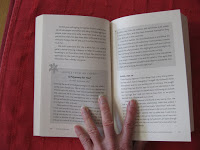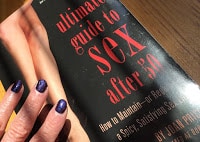Posts Tagged ‘sex research’
Seniors: How (and what) is your sex life?
It occurs to me that after 11 years of talking out loud (shouting, insisting, cajoling, writing) about senior sex, the questions that interviewers ask me have become quite intelligent and open-minded.
When I first started this work, interviewers would ask elementary questions (e.g. “Is it true that seniors are having sex?”) and would often place a value judgement on what they heard (e.g. “Yeah, but eeuuww, the idea of my parents/grandparents having sex…!”)
But now, however young the interviewer is, there’s an open attitude, a nonjudgmental striving to understand. It’s not such an odd idea anymore that we aren’t retiring our genitals at some arbitrary age. This is progress! Or am I just lucky enough to be interviewed by smarter, more sex-positive interviewers?
One topic that interviewers find endlessly fascinating is that we’re not settling into old age passively or predictably. Many of us decide that it’s time to go after what we want, whether or not it’s what we used to want or ever thought we’d want.
 I wrote about this in the “Stretching Boundaries” chapter of The Ultimate Guide to Sex after 50, and many of you contributed your experiences in the “Off the Beaten Path: Nontraditional Sex Practices and Relationships” in Naked at Our Age. I’m often asked, “What percentage of seniors are into kink?” or “Are many seniors polyamorous?” or “Are most seniors happier with their sex lives than they were when they were young?” I sometimes answer, “I don’t collect statistics — I collect stories.”
I wrote about this in the “Stretching Boundaries” chapter of The Ultimate Guide to Sex after 50, and many of you contributed your experiences in the “Off the Beaten Path: Nontraditional Sex Practices and Relationships” in Naked at Our Age. I’m often asked, “What percentage of seniors are into kink?” or “Are many seniors polyamorous?” or “Are most seniors happier with their sex lives than they were when they were young?” I sometimes answer, “I don’t collect statistics — I collect stories.”
Yes, some studies have been done, but more often than not, research and surveys either overlook our generation entirely or only study straight relationships and define sex as heterosexual intercourse, which is just one form of sexual expression. I don’t think that our generation is being asked the right questions about what we do, what we want, and how we feel about it.
So I’m opening this up to you: If you’re over 50 (lots older is fine!) and you find that your ideas have changed about what you want your sex life to be, please feel free to comment with your views and especially how those views have changed in recent years. Please give yourself a first name (doesn’t have to be real) instead of “Anonymous” and include your real age. (If you have any trouble posting a comment, email me with the subject line “blog comment: how and what” and include what you want to say, what name you want to use, and your age, and I’ll post it for you.)
I started this discussion on my Naked at Our Age Facebook page, which I hope you’ll read, “like,” and share. Thanks!
Learn more about my most recent book, The Ultimate Guide to Sex after 50. Order here for an autographed copy, purchase from your local independent bookstore, or order from Amazon.
Bonk by Mary Roach: book review
 Bonk: The Curious Coupling of Science and Sex by Mary Roachis the most entertaining — and, in a madcap way, the most informative — book I’ve read in years. Filled with the weirdness of both the procedures and findings of sex research, Bonk combines arcane details with amazing facts and research tools (e.g. the “penis-camera).
Bonk: The Curious Coupling of Science and Sex by Mary Roachis the most entertaining — and, in a madcap way, the most informative — book I’ve read in years. Filled with the weirdness of both the procedures and findings of sex research, Bonk combines arcane details with amazing facts and research tools (e.g. the “penis-camera).
Regale your friends with anecdotes from this book, and you’ll be the life of the party – as long as the party is filled with open-minded friends who enjoy zany details about sex.
Mary Roach writes in a clever, often hilarious style, which makes her books a pleasure to read, whether she’s writing about cadavers (Stiff: The Curious Lives of Human Cadavers ), the afterlife (Spook: Science Tackles the Afterlife), or, in this case, sex. My copy quickly became spotted with Post-Its as I read, marking passages I simply had to tell you about, but numbering an impossible 45 markers by the time I finished.
Here’s just a small sampling of the facts I learned:
Princess Marie Bonaparte (great-grand-niece of Napoleon) blamed her inability to orgasm during intercourse on the fact that her clitoris was three centimeters away from her vagina. She did her own research in 1924 with a ruler and interviews and discovered that “téléclitoridiennes,” women with more than 2.5 centimeters between clitoris and vagina, were incapable of orgasm during intercourse. So she employed a surgeon to relocate her clitoris. (No, sorry, it didn’t work for her.)
Women don’t like men’s cologne, according to their rate of vaginal blood flow. The scent of men’s cologne actually reduced vaginal blood flow, as did the smell of charcoal-barbecue meat. Oddly, what increased vaginal blood flow the most (by 13%) was a mixture of cucumber and Good’n’ Plenty candy. Hmmm.
[describing one of many sex machine inventions:] “The motor housing is the size of a lunchbox and is raised on one end, like a slide projector. A flesh-colored phallus on a stick slides quietly in and out. The erotic appeal seems limited. It would be like dating a corn dog.”
[describing another sex machine invention, called “Therapeutic Apparatus for Relieving Sexual Frustrations in Women Without Sex Partners”:] “At the base of the penial assembly was a wide, black, wiry cuff of fur-like or hair-like material. For the partnerless woman who wants not only the ultimate climax or orgasm, but also the feeling that she is having sex with a shoe buffer.”
You’ll learn about “uterine upsuck” in pigs and how Danish farmers increased their pigs’ fertility by sexually stimulating their sows to “upsuck” the semen better. Why it rarely worked to use an MRI to study couples having sex. How porn stars make extra money by having their orifices replicated into plaster casts which are then used for sex dolls. And what Mary Roach and her husband did in full view of scientists to further sex research.
Some of the most intriguing diversions are found in the footnotes. Did you know that Victorian gynecologists and urologists wouldn’t look at the nether parts of the women they were examining? Can you guess why men land in emergency rooms when they can’t remove their improvised cock rings? Or the strangest foreign objects that have been removed from rectums? (I can’t decide whether to vote for the frozen pig tail or the spectacles.)
I highly recommend Bonk for your own delight and as gifts for your sex-minded friends.
[Read my interview with Mary Roach here.]
Do you have a G-spot?
Actually, I’m not worried. As Dr. Petra Boynton says in her astute blog post today that’s as smart as it is entertaining — “Where have all the g spots gone?”:
It’s pretty simple. Women are diverse. Some of us really enjoy vaginal stimulation by finger, penis, sex toy (or other item). Some women prefer clitoral, anal, breast or other stimulation. Research that tells us we should focus exclusively on one spot or ignore it completely does little to reassure us or enhance our sex lives.
We’re all different, and other than the brain and clitoris being our #1 and #2 pleasure organs (in that order), we all experience sexual pleasure a bit differently, sometimes a lot differently. Maybe, Boynton suggests, the G-spot has become the subject of so much media attention because “as any journalist will tell you it’s much easier to get a g spot past your editor than mention the clitoris.”
In this study, “Genetic and environmental influences on self reported g spots in women: A twin study,” soon to be published in the Journal of Sexual Medicine,1875 women, aged 22-83 with a mean age of 55, answered questions about sex in a mailed questionnaire. Women were asked about their sexual practices and activity, and how frequently they experienced orgasm during intercourse and through masturbation.
The study used twins because, supposedly, if the G-spot is truly genetic, then both twins would report having one, which apparently did not happen. Does that mean they don’t, though? I didn’t get in touch (so to speak) with mine, if indeed I do have one, until a digitally dexterous lover pointed it out (again, so to speak) to me. Did these twins share lovers?
I was surprised to learn that only the answers of heterosexual women who engaged in vaginal intercourse were counted — why was that? 71 lesbian and bisexual women were excluded “because of the common use of digital stimulation among these women, which may bias the results.” Wait a minute. Can’t we learn the most about the elusive G-spot from women whose primary sexual expression is digital? I’m confused.
For me, the bottom line is this: Whether the G-spot exists or not, I hope you’re enjoying yours!
Don’t miss this spoof from the Daily Mash, MEN WHO CARE ABOUT THE G-SPOT ARE A MYTH, SAY EXPERTS.
Thank you, Dr. Petra Boynton — researcher, sex educator, and “agony aunt” — for your blog post that spurred mine.
“I am not easily repulsed”: interview with Mary Roach
 Mary Roach writes books on weird scientific research about subjects we’ve all wondered about. She is the author of Stiff: The Curious Lives of Human Cadavers, Spook: Science Tackles the Afterlife, and – her latest and my favorite – Bonk: The Curious Coupling of Science and Sex. I’ve long enjoyed Roach’s quirky style that often has me chortling as I read. Reading a whole book about my favorite topic (sex, not cadavers) was delicious.
Mary Roach writes books on weird scientific research about subjects we’ve all wondered about. She is the author of Stiff: The Curious Lives of Human Cadavers, Spook: Science Tackles the Afterlife, and – her latest and my favorite – Bonk: The Curious Coupling of Science and Sex. I’ve long enjoyed Roach’s quirky style that often has me chortling as I read. Reading a whole book about my favorite topic (sex, not cadavers) was delicious.
In a separate blog post, I’ve reviewed Bonk and quoted delightful tidbits that will send you running to read the book and give it to all your friends. Here with my interview with the author, Mary Roach:
JP: As cool-headed and sharp-witted as you are, some parts of your research must have embarrassed or repulsed you. What do you wish you had never done or learned, and why? Tell the truth!
MR: As readers of Stiff have probably figured out, I am not easily repulsed. At least not by the physical. I am repulsed by close-mindedness, petty hatred, greed, intolerance, ignorance. But not penises or vaginas or sex. But bear in mind, I was hanging out in sex labs, not fringe sex clubs South of Market. Honestly, it’s pretty tame stuff. Embarrassment-wise, well, there was the Dr. Deng scenario. Ed and I were scanned in 4-D ultrasound in the act. That was awkward, for sure, but I knew how much fun it was going to be to write it up, and so it hardly bothered me. Mostly, I felt guilty for dragging my husband into the fray.
JP: What have you seen or learned since you finished the book that you wish you could have included?
MR: Oh, people are always emailing me or coming up to me at talks and dropping all manner of irresistible tidbits that I wish I’d known about while working on the book. One man raised his hand and said, “Are you aware of the phenomenon of surfing sperm?” Apparently they surf the secretions on the vaginal walls. Another man, a gynecologist now in his seventies, emailed to tell me a story that William Masters had told him about meeting a bishop or cardinal, I forget which. His Holiness had asked to hear about the research Masters and Johnson were doing. He listened quite intently, and when Masters had finished speaking, he said, “Very good. Your work might serve to prevent a lot of divorces. Of course, if I am asked about it in public, I will condemn you.” Would have loved to include those!
JP: My blog is directed at older readers (most are 60-80) who are interested in sex. What did you learn specific to elder sex, aside from Viagra? If little or nothing, can you talk about why you think scientific research is NOT being done on elder sex, other than taking surveys? Is it the “ick factor,” as I call it?
MR: There was a large survey that was published not long ago about frequency of sex and satisfaction levels among people over 75, I think it was. The problem, as I recall it, was that so many of the women at that age were widows. I didn’t cover this because as you know it’s a book about laboratory-based sex research — the physiological stuff: arousal and orgasm and such. Rather than the behavioral issues. I cover the two physiological old-age biggies — erectile dysfunction in men and libido issues in women. I had wanted to include a chapter specifically on sex in the upper reaches of old age, but physiologically speaking, it seemed to be a matter of degree, rather than unique issues. In other words, more ED and lower libido… I don’t think of sex researchers as people who easily succumb to the ick factor — my god, look at Marcalee Sipski and her orgasm work with quadriplegics. If they were, they wouldn’t have gotten into arousal and orgasm research in the first place. Then again, I think old age is actually more of a taboo than sex these days, so perhaps it is the ick factor that keeps researchers away.
JP: What’s the most unusual experience you had while promoting this book? I imagine people came up to you and told you all sorts of things you’d rather not know.
MR: Call-in radio shows are always entertaining. The DJs will often bill me as a therapist or a researcher, and then open up the lines and say, “We’ll be taking ALL your questions on sex!” And I’m in the studio with this panicked look, mouthing NOOOOOO! Because I’m a writer — I only know about what I wrote about in the book. I don’t know, say, whether it’s a myth that the Hoo-ha tribe in the Amazon has blue testicles or what the best natural alternative to Viagra is. People do come up after readings and confide all manner of intimate things. It doesn’t bother me. I guess I’m used to it. I just wish I had better answers for them.
JP: What’s the next book (if you’ve decided)?
MR: Yes, I’m writing about the fabulous insanity of space travel, of staying alive in a world for which we are utterly ill-equipped. Lots of fun aeromedical history stuff, field trips to Moscow and the Japanese Space Agency, etc.
[Read my review of Mary Roach’s Bonk here.]

